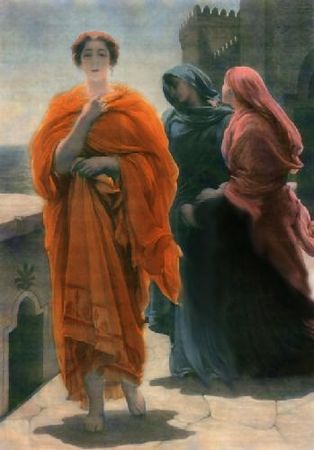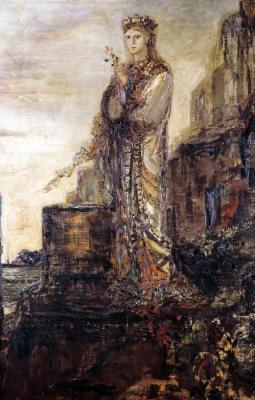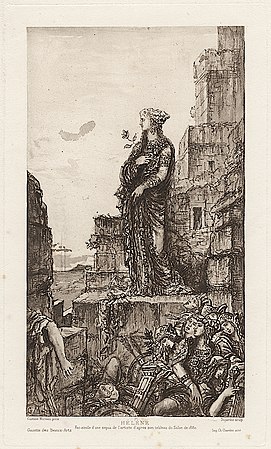Helen of Troy
| Helen | |
|---|---|
Queen of Sparta Princess ofTroy | |
 | |
| Abode | Sparta(modern-daySparta,Greece) Troy(modern-dayHisarlik,Turkey) |
| Genealogy | |
| Born | |
| Died | |
| Parents | |
| Siblings | Pollux(full-brother) Clytemnestra,Castor,Timandra,Phoebe,Philonoeandother children of Zeus(half-siblings) |
| Consort | Menelaus Paris Deiphobus |
| Offspring | At least 5, includingHermione
|
Helen(Ancient Greek:Ἑλένη,romanized:Helénē[a]), also known asHelen of Troy,[2][3]Helen of Argos,orHelen of Sparta,[4]and inLatinasHelena,[5]was a figure inGreek mythologysaid to have been the most beautiful woman in the world. She was believed to have been the daughter ofZeusandLedaorNemesis,and the sister ofClytemnestra,Castor, Pollux,Philonoe,PhoebeandTimandra.She was married to KingMenelausofSparta"who became by her the father ofHermione,and, according to others, ofNicostratusalso. "[5]Her abduction byParis of Troywas the most immediate cause of theTrojan War.
Elements of her putative biography come from classical authors such asAristophanes,Cicero,Euripides,andHomer(in both theIliadand theOdyssey). Her story reappears in Book II ofVirgil'sAeneid.In her youth, she was abducted byTheseus.A competition between her suitors for her hand in marriage saw Menelaus emerge victorious. All of her suitors were required to swear an oath (known as theOath ofTyndareus) promising to provide military assistance to the winning suitor, if Helen were ever stolen from him. The obligations of the oath precipitated the Trojan War. When she married Menelaus she was still very young; whether her subsequent departure with Paris was an abduction or anelopementis ambiguous (probably deliberately so).
The legends of Helen during her time in Troy are contradictory: Homer depicts her ambivalently, both regretful of her choice and sly in her attempts to redeem her public image. Other accounts have a treacherous Helen who simulatedBacchicrites and rejoiced in the carnage she caused. In some versions, Helen doesn't arrive in Troy, but instead waits out the war inEgypt.[6]Ultimately, Paris was killed in action, and in Homer's account Helen was reunited with Menelaus, though other versions of the legend recount her ascending to Olympus instead. A cult associated with her developed in HellenisticLaconia,both at Sparta and elsewhere; atTherapneshe shared a shrine with Menelaus. She was also worshiped inAtticaand onRhodes.

Her beauty inspired artists of all times to represent her, frequently as the personification of ideal human beauty. Images of Helen start appearing in the 7th century BC. In classical Greece, her abduction by Paris—or escape with him—was a popular motif. In medieval illustrations, this event was frequently portrayed as a seduction, whereas in Renaissance paintings it was usually depicted as a "rape" (i. e.,abduction) by Paris.[b]Christopher Marlowe's lines from his tragedyDoctor Faustus(1604) are frequently cited: "Was this the face that launched a thousand ships / And burnt the topless towers of Ilium?"[c]
Etymology[edit]
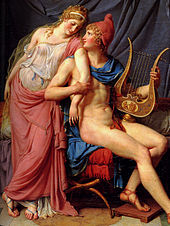
TheetymologyofHelen's namecontinues to be a problem for scholars. In the 19th century,Georg CurtiusrelatedHelen(Ἑλένη) to the moon (Selene;Σελήνη). But two early dedications to Helen in the Laconian dialect of ancient Greek spell her name with an initialdigamma(Ϝ, probably pronounced like a w), which rules out any etymology originally starting with simple*s-.[7]
In the early 20th century, Émile Boisacq considered Ἑλένη to derive from the well-known nounἑλένηmeaning "torch".[8]It has also been suggested that the λ ofἙλένηarose from an original ν, and thus the etymology of the name would be connected with the root ofVenus.Linda Lee Clader, however, says that none of the above suggestions offers much satisfaction.[9][f]
More recently,Otto Skutschhas advanced the theory that the name Helen might have two separate etymologies, which belong to different mythological figures respectively, namely*Sṷelenā(related toSanskritsvaraṇā"the shining one" ) and*Selenā,the first a Spartan goddess, connected to one or the other natural light phenomenon (especiallySt. Elmo's fire) and sister of theDioscuri,the other a vegetation goddess worshiped inTherapneas Ἑλένα Δενδρῖτις ( "Helena of the Trees" ).[12]
Others have connected the name's etymology to a hypotheticalProto-Indo-Europeansun goddess,noting the name's connection to the word for "sun" in various Indo-European cultures[13]including the Greek proper word and god for the sun,Helios.[14][15][16][12]In particular, her marriage myth may be connected to a broader Indo-European "marriage drama" of the sun goddess, and she is related to thedivine twins,just as many of these goddesses are.[17]Martin L. Westhas thus proposed thatHelena( "mistress of sunlight" ) may be constructed on thePIEsuffix-nā( "mistress of" ), connoting a deity controlling a natural element.[18]
Prehistoric and mythological context[edit]

Helen first appears in the poems ofHomer,after which she became a popular figure in Greek literature. These works are set in the final years of theAge of Heroes,a mythological era which features prominently in the canon of Greek myth. Because the Homeric poems are known to have been transmitted orally before being written down, some scholars speculate that such stories were passed down from earlierMycenaean Greektradition, and that the Age of Heroes may itself reflect a mythologized memory of that era.[19]
Recent archaeological excavations inGreecesuggest that modern-dayLaconiawas a distinct territory in theLate Bronze Age,while the poets narrate that it was a rich kingdom. Archaeologists have unsuccessfully looked for a Mycenaean palatial complex buried beneath present-day Sparta.[20]Modern findings suggest the area aroundMenelaionin the southern part of theEurotasvalley seems to have been the center of Mycenaean Laconia.[21]
Family[edit]
Helen and Menelaus had a daughter,Hermione.Different sources say she was also the mother of one or more sons, namedAethiolas,Nicostratus,MegapenthesandPleisthenes.Still, according to others, these were instead illegitimate children of Menelaus and various lovers.
Helen and Paris had three sons,Bunomus,Aganus,Idaeus,and a daughter also calledHelen.[22]The three sons died during the Trojan War when an earthquake caused the roof of the room where they slept to collapse.
Mythology[edit]
Birth[edit]
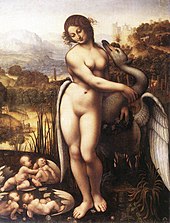

In most sources, including theIliadand theOdyssey,Helen is the daughter ofZeusand ofLeda,the wife of the Spartan kingTyndareus.[23]Euripides' playHelen,written in the late 5th century BC, is the earliest source to report the most familiar account of Helen's birth: that, although her putative father was Tyndareus, she was actually Zeus' daughter. In the form of a swan, the king of gods was chased by an eagle, and sought refuge with Leda. The swan gained her affection, and the two mated. Leda then produced anegg,from which Helen emerged.[24]The FirstVatican Mythographerintroduces the notion that two eggs came from the union: one containingCastor and Pollux;one with Helen andClytemnestra.Nevertheless, the same author earlier states that Helen, Castor and Pollux were produced from a single egg.[25]Fabius Planciades Fulgentiusalso states that Helen, Castor and Pollux are born from the same egg.[26]Pseudo-Apollodorusstates that Leda had intercourse with both Zeus and Tyndareus the night she conceived Helen.[27]
On the other hand, in theCypria,part of theEpic Cycle,Helen was the daughter of Zeus and the goddessNemesis.[1]The date of theCypriais uncertain, but it is generally thought to preserve traditions that date back to at least the 7th century BC. In theCypria,Nemesis did not wish to mate with Zeus. She therefore changed shape into various animals as she attempted to flee Zeus, finally becoming a goose. Zeus also transformed himself into a goose and raped Nemesis, who produced an egg from which Helen was born.[28]Presumably, in theCypria,this egg was somehow transferred to Leda.[g]Later sources state either that it was brought to Leda by a shepherd who discovered it in a grove inAttica,or that it was dropped into her lap byHermes.[29]
Asclepiades of Tragilos andPseudo-Eratosthenesrelated a similar story, except that Zeus and Nemesis became swans instead of geese.[30]Timothy Gantzhas suggested that the tradition that Zeus came to Leda in the form of a swan derives from the version in which Zeus and Nemesis transformed into birds.[31]
Pausaniasstates that in the middle of the 2nd century AD, the remains of an egg-shell, tied up in ribbons, were still suspended from the roof of a temple on the Spartan acropolis. People believed that this was "the famous egg that legend says Leda brought forth". Pausanias traveled to Sparta to visit the sanctuary, dedicated toHilaeiraandPhoebe,in order to see the relic for himself.[32]
Pausaniasalso says that there was a local tradition that Helen's brothers, "theDioscuri"(i.e. Castor and Pollux), were born on the island ofPefnos,adding that the Spartan poetAlcmanalso said this,[33]while the poetLycophron's use of the adjective "Pephnaian" (Πεφναίας) in association with Helen, suggests that Lycophron may have known a tradition which held that Helen was also born on the island.[34]
Youthful abduction by Theseus[edit]

TwoAthenians,TheseusandPirithous,thought that since they were sons of gods, they should have divine wives; they thus pledged to help each other abduct two daughters ofZeus.Theseus chose Helen, and Pirithous vowed to marryPersephone,the wife ofHades.Theseus took Helen and left her with his motherAethraor his associate Aphidnus atAphidnaeorAthens.Theseus and Pirithous then traveled to theunderworld,the domain of Hades, to kidnap Persephone. Hades pretended to offer them hospitality and set a feast, but, as soon as the pair sat down, snakes coiled around their feet and held them there. Helen's abduction caused an invasion of Athens by Castor and Pollux, who captured Aethra in revenge, and returned their sister to Sparta.[35]InGoethe'sFaust,CentaurChironis said to have aided the Dioscuri brothers in returning Helen home.
In most accounts of this event, Helen was quite young;Hellanicus of Lesbossaid she was seven years old andDiodorusmakes her ten years old.[36]On the other hand,Stesichorussaid thatIphigeniawas the daughter of Theseus and Helen, which implies that Helen was of childbearing age.[37]In most sources, Iphigenia is the daughter ofAgamemnonandClytemnestra,butDuris of Samosand other writers, such asAntoninus Liberalis,followed Stesichorus' account.[38]
Ovid'sHeroidesgive us an idea of how ancient and, in particular,Roman authorsimagined Helen in her youth: she is presented as a young princess wrestling naked in thepalaestra,alluding to a part of girls' physical education in classical (not Mycenaean) Sparta.Sextus Propertiusimagines Helen as a girl who practices arms and hunts with her brothers:[39]
[...] or like Helen, on the sands of Eurotas, between Castor and Pollux, one to be victor in bo xing, the other with horses: with naked breasts she carried weapons, they say, and did not blush with her divine brothers there.
Suitors[edit]

When it was time for Helen to marry, many kings and princes from around the world came to seek her hand, bringing rich gifts with them or sent emissaries to do so on their behalf. During the contest, Castor and Pollux had a prominent role in dealing with the suitors, although the final decision was in the hands of Tyndareus.[41]Menelaus, her future husband, did not attend but sent his brother,Agamemnon,to represent him.
Oath of Tyndareus[edit]
Tyndareus was afraid to select a husband for his daughter, or send any of the suitors away, for fear of offending them and giving grounds for a quarrel.Odysseuswas one of the suitors, but had brought no gifts because he believed he had little chance to win the contest. He thus promised to solve the problem, if Tyndareus in turn would support him in his courting ofPenelope,the daughter ofIcarius.Tyndareus readily agreed, and Odysseus proposed that, before the decision was made, all the suitors should swear a most solemn oath to defend the chosen husband against whoever should quarrel with him. After the suitors had sworn not to retaliate, Menelaus was chosen to be Helen's husband. As a sign of the importance of the pact, Tyndareussacrificed a horse.[42]Helen and Menelaus became rulers of Sparta, after Tyndareus and Leda abdicated. Menelaus and Helen rule in Sparta for at least ten years; they have a daughter,Hermione,and (according to some myths) three sons:Aethiolas,Maraphius, andPleisthenes.
The marriage of Helen and Menelaus marks the beginning of the end of the age of heroes. Concluding the catalog of Helen's suitors, Hesiod reports Zeus' plan to obliterate the race of men and the heroes in particular. The Trojan War, caused by Helen's elopement with Paris, is going to be his means to this end.[43]
Seduction or kidnapping by Paris[edit]

Paris,a Trojan prince, came to Sparta to claim Helen, in the guise of a supposed diplomatic mission. Before this journey, Paris had been appointed by Zeus tojudge the most beautiful goddess;Hera,Athena,orAphrodite.In order to earn his favour, Aphrodite promised Paris the most beautiful woman in the world. Swayed by Aphrodite's offer, Paris chose her as the most beautiful of the goddesses, earning the wrath ofAthenaandHera.
Although Helen is sometimes depicted as being raped by Paris, Ancient Greek sources are often elliptical and contradictory.Herodotusstates that Helen was abducted, but theCypriasimply mentions that after giving Helen gifts, "Aphrodite brings the Spartan queen together with the Prince of Troy."[44]Sapphoargues that Helen willingly left behind Menelaus and their nine-year-old daughter,Hermione,to be with Paris:
Some say a host of horsemen, others of infantry and others
of ships, is the most beautiful thing on the dark earth
but I say, it is what you love
Full easy it is to make this understood of one and all: for
she that far surpassed all mortals in beauty, Helen her
most noble husband
Deserted, and went sailing to Troy, with never a thought for
her daughter and dear parents.— Sappho,fragment 16(Voigt)[45]
Dio Chrysostomgives a completely different account of the story, questioning Homer's credibility: after Agamemnon had married Helen's sister, Clytemnestra, Tyndareus sought Helen's hand for Menelaus for political reasons. However, Helen was sought by many suitors, who came from far and near, among them Paris who surpassed all the others and won the favor of Tyndareus and his sons. Thus he won her fairly and took her away to Troia, with the full consent of her natural protectors.[46]Cyprianarrate that in just three days Paris and Helen reached Troy. Homer narrates that during a brief stop-over in the small island ofKranai,according toIliad,the two lovers consummated their passion. On the other hand,Cyprianote that this happened the night before they left Sparta.[47]
-
In western painting, Helen's journey to Troy is usually depicted as a forced abduction.The Rape of HelenbyFrancesco Primaticcio(c. 1530–1539,Bowes Museum) is representative of this tradition.
-
InGuido Reni's painting (1631, Louvre, Paris), however, Paris holds Helen by her wrist (as he already did in Genga's painting shown here on the left), and leave together for Troia.
-
The Rape of HelenbyTintoretto(1578–1579,Museo del Prado,Madrid); Helen languishes in the corner of a land-sea battle scene.[48]
-
El Juicio de ParisbyEnrique Simonet,c. 1904. This painting depicts Paris' judgement. He is inspecting Aphrodite, who is standing naked before him. Hera and Athena watch nearby.
In Egypt[edit]
At least three Ancient Greek authors denied that Helen ever went to Troy; instead, they suggested, Helen stayed in Egypt during the Trojan War. Those three authors are Euripides, Stesichorus, and Herodotus.[49][50]In the version put forth by Euripides in his playHelen,Herafashioned a likeness (eidolon,εἴδωλον) of Helen out of clouds at Zeus' request,Hermestook her to Egypt, and Helen never went to Troy, but instead spent the entire war inEgypt.Aneidolonis also present inStesichorus' account, but not in Herodotus' rationalizing version of the myth. In addition to these accounts,Lycophron(822) states thatHesiodwas the first to mention Helen'seidolon.[51]This may mean Hesiod stated this in a literary work, or that the idea was widely known/circulated in early archaic Greece during the time of Hesiod and was consequently attributed to him.[51]
Herodotusadds weight to the "Egyptian" version of events by putting forward his own evidence—he traveled to Egypt and interviewed the priests of the temple (Foreign Aphrodite,ξείνη Ἀφροδίτη) atMemphis.According to these priests, Helen had arrived in Egypt shortly after leaving Sparta, because strong winds had blown Paris's ship off course. KingProteus of Egypt,appalled that Paris had seduced hishost'swife and plundered his host's home in Sparta, disallowed Paris from taking Helen to Troy. Paris returned to Troy without a new bride, but the Greeks refused to believe that Helen was in Egypt and not within Troy's walls. Thus, Helen waited in Memphis for ten years, while the Greeks and the Trojans fought. Following the conclusion of the Trojan War, Menelaus sailed to Memphis, where Proteus reunited him with Helen.[52]
In Troy[edit]
When he discovered that his wife was missing, Menelaus called upon all the other suitors to fulfill their oaths, thus beginning the Trojan War.
The Greek fleet gathered inAulis,but the ships could not sail for lack of wind.Artemiswas enraged by a sacrilege, and only the sacrifice of Agamemnon's daughter,Iphigenia,could appease her. In EuripidesIphigenia in Aulis,Clytemnestra, Iphigenia's mother and Helen's sister, begs her husband to reconsider his decision, calling Helen a "wicked woman". Clytemnestra tries to warn Agamemnon that sacrificing Iphigenia for Helen's sake is, "buying what we most detest with what we hold most dear".[53][54]
-
Helen on the Ramparts of Troywas a popular theme in late 19th-century art – seen here a depiction byFrederick Leighton.
-
In a similar fashion to Leighton,Gustave Moreaudepicts an expressionless Helen; a blank or anguished face.
-
Lithographicillustration by Walter Crane
-
Paul Dujardin after Gustave Moreau,Hélène,photogravure, 1880
Before the opening of hostilities, the Greeks dispatched a delegation to the Trojans under Odysseus and Menelaus; they endeavored without success to persuadePriamto hand Helen back. A popular theme,The Request of Helen(Helenes Apaitesis, Ἑλένης Ἀπαίτησις), was the subject of a drama bySophocles,now lost.[h][55]
Homer paints a poignant, lonely picture of Helen in Troy. She is filled with self-loathing and regret for what she has caused; by the end of the war, the Trojans have come to hate her. WhenHectordies, she is the third mourner at his funeral, and she says that, of all the Trojans, Hector andPriamalone were always kind to her:[56][57]
Wherefore I wail alike for thee and for my hapless self with grief at heart;
for no longer have I anyone beside in broad Troy that is gentle to me or kind;
but all men shudder at me.[58]
These bitter words reveal that Helen gradually realized Paris' weaknesses, and decided to ally herself with Hector. There is an affectionate relationship between the two, and Helen has harsh words for Paris when she compares the two brothers:[57][59]
Howbeit, seeing the gods thus ordained these ills,
would that I had been wife to a better man,
that could feel the indignation of his fellows and their many revilings. [...]
But come now, enter in, and sit thee upon this chair, my brother,
since above all others has trouble encompassed thy heart
because of shameless me, and the folly of Alexander.[60][56]
After Paris was killed in combat, there was some dispute among the Trojans about which of Priam's surviving sons she should remarry:HelenusorDeiphobus,but she was given to the latter.
During the Fall of Troy[edit]


During the fall of Troy, Helen's role is ambiguous. InVirgil'sAeneid,Deiphobus gives an account of Helen's treacherous stance: when theTrojan Horsewas admitted into the city, she feignedBacchic rites,leading a chorus of Trojan women, and, holding a torch among them, she signaled to the Greeks from the city's central tower. In theOdyssey,however, Homer narrates a different story: Helen circled the Horse three times, and she imitated the voices of the Greek women left behind at home—she thus tortured the men inside (including Odysseus and Menelaus) with the memory of their loved ones, and brought them to the brink of destruction.[61]
After the deaths of Hector and Paris, Helen became the paramour of their younger brother, Deiphobus; but when the sack of Troy began, she hid her new husband's sword, and left him to the mercy of Menelaus and Odysseus. InAeneid,Aeneasmeets the mutilated Deiphobus inHades;his wounds serve as a testimony to his ignominious end, abetted by Helen's final act of treachery.[62]
However, Helen's portraits in Troy seem to contradict each other. From one side, we read about the treacherous Helen who simulated Bacchic rites and rejoiced over the carnage of Trojans. On the other hand, there is another Helen, lonely and helpless; desperate to find sanctuary, while Troy is on fire. Stesichorus narrates that both Greeks and Trojans gathered to stone her to death.[63]When Menelaus finally found her, he raised his sword to kill her. He had demanded that only he should slay his unfaithful wife; but, when he was ready to do so, she dropped her robe from her shoulders, and the sight of her beauty caused him to let the sword drop from his hand.[i]Electrawails:[64]
Alas for my troubles! Can it be that her beauty has blunted their swords?
Fate[edit]
Helen returned toSpartaand lived with Menelaus, where she was encountered by Telemachus in Book 4 ofThe Odyssey.As depicted in that account, she and Menelaus were completely reconciled and had a harmonious married life—he holding no grudge at her having run away with a lover and she feeling no restraint in telling anecdotes of her life inside besieged Troy.
According to another version, used byEuripidesin his playOrestes,Helen had been saved byApollofrom Orestes[65]and was taken up toMount Olympusalmost immediately after Menelaus' return. A curious fate is recounted byPausanias the geographer(3.19.11–13), which has Helen share the afterlife with Achilles.[66]
Pausanias also has another story (3.19.9–10): "The account of the Rhodians is different. They say that when Menelaus was dead, andOrestesstill a wanderer, Helen was driven out byNicostratusandMegapenthesand came toRhodes,where she had a friend inPolyxo,the wife ofTlepolemus.For Polyxo, they say, was an Argive by descent, and when she was already married to Tlepolemus, shared his flight to Rhodes. At the time she was queen of the island, having been left with an orphan boy. They say that this Polyxo desired to avenge the death of Tlepolemus on Helen, now that she had her in her power. So she sent against her when she was bathing handmaidens dressed up asFuries,who seized Helen and hanged her on a tree, and for this reason the Rhodians have a sanctuary of Helen of the Tree. "[67]There are other traditions concerning the punishment of Helen. For example, she is offered as a sacrifice to the gods in Tauris byIphigeneia,orThetis,enraged when Achilles dies because of Helen, kills her on her return journey.[68]
Tlepolemus was a son ofHeraclesand Astyoche. Astyoche was a daughter of Phylas, King of Ephyra who was killed by Heracles. Tlepolemus was killed bySarpedonon the first day of fighting in theIliad.Nicostratus was a son of Menelaus by his concubine Pieris, an Aetolian slave.Megapentheswas a son of Menelaus by his concubine Tereis, with no further origin.
InEuripides's tragedyThe Trojan Women,Helen is shunned by the women who survived the war and is to be taken back to Greece to face a death sentence. This version is contradicted by two of Euripides' other tragedies,Electra,which predates The Trojan Women, andHelen,as Helen is described as being in Egypt during the events of the Trojan War in each.
Artistic representations[edit]

From Antiquity, depicting Helen would be a remarkable challenge. The story ofZeuxisdeals with this exact question: how would an artist immortalize ideal beauty?[70]He eventually selected the best features from five virgins. The ancient world starts to paint Helen's picture or inscribe her form on stone, clay and bronze by the 7th century BC.[71]Dares Phrygiusdescribes Helen in hisHistory of the Fall of Troy:"She was beautiful, ingenuous, and charming. Her legs were the best; her mouth the cutest. There was a beauty-mark between her eyebrows."[72]
Helen is frequently depicted on Athenian vases as being threatened by Menelaus and fleeing from him. This is not the case, however, in Laconic art: on anArchaicsteledepicting Helen's recovery after the fall of Troy, Menelaus is armed with a sword but Helen faces him boldly, looking directly into his eyes; and in other works of Peloponnesian art, Helen is shown carrying a wreath, while Menelaus holds his sword aloft vertically. In contrast, on Athenian vases of c. 550–470, Menelaus threateningly points his sword at her.[73]

The abduction by Paris was another popular motif inancient Greek vase-painting;definitely more popular than the kidnapping by Theseus. In a famous representation by the Athenian vase painterMakron,Helen follows Paris like a bride following a bridegroom, her wrist grasped by Paris' hand.[74]TheEtruscans,who had a sophisticated knowledge of Greek mythology, demonstrated a particular interest in the theme of the delivery of Helen's egg, which is depicted in relief mirrors.[75]
InRenaissancepainting, Helen's departure from Sparta is usually depicted as a scene of forcible removal (rape) by Paris. This is not, however, the case with certain secular medieval illustrations. Artists of the 1460s and 1470s were influenced byGuido delle Colonne'sHistoria destructionis Troiae,where Helen's abduction was portrayed as a scene of seduction. In theFlorentine Picture ChronicleParis and Helen are shown departing arm in arm, while their marriage was depicted into Franco-Flemish tapestry.[76]
InChristopher Marlowe'sDoctor Faustus(1604),Faustconjurestheshadeof Helen. Upon seeing Helen, Faustus speaks the famous line: "Was this the face that launch'd a thousand ships, / And burnt the topless towers of Ilium." (Act V, Scene I.) Helen is also conjured by Faust inGoethe'sFaust.
InWilliam Shakespeare's playTroilus and Cressida,Helen is a minor character who adores Troilus.
InPre-Raphaeliteart, Helen is often shown with shining curly hair and ringlets. Other painters of the same period depict Helen on the ramparts of Troy, and focus on her expression: her face is expressionless, blank, inscrutable.[77]InGustave Moreau's painting, Helen will finally become faceless; a blankeidolonin the middle of Troy's ruins.
Cult[edit]
The major centers of Helen's cult were in Laconia. At Sparta, the urban sanctuary of Helen was located near the Platanistas, so called for the plane trees planted there. Ancient sources associate Helen with gymnastic exercises or/and choral dances of maidens near theEvrotas River.This practice is referenced in the closing lines ofLysistrata,where Helen is said to be the "pure and proper" leader of the dancing Spartan women.Theocritusconjures the songepithalamiumSpartan women sung at Platanistas commemorating the marriage of Helen and Menelaus:[78]
We first a crown of low-growing lotus
having woven will place it on a shady plane-tree.
First from a silver oil-flask soft oil
drawing we will let it drip beneath the shady plane-tree.
Letters will be carved in the bark, so that someone passing by
may read in Doric: "Reverence me. I am Helen's tree."
Helen's worship was also present on the opposite bank of Eurotas atTherapne,where she shared a shrine with Menelaus and the Dioscuri. The shrine has been known as theMenelaion(the shrine of Menelaus), and it was believed to be the spot where Helen was buried alongside Menelaus. Despite its name, both the shrine and the cult originally belonged to Helen; Menelaus was added later as her husband.[79]In addition, there was a festival at the town, which was called Meneleaeia (Μενελάεια) in honour of Menelaus and Helen.[80] Isocrateswrites that at Therapne Helen and Menelaus were worshiped as gods, and not as heroes. Clader argues that, if indeed Helen was worshiped as a goddess at Therapne, then her powers should be largely concerned with fertility,[81]or as asolar deity.[82]There is also evidence for Helen's cult in Hellenistic Sparta: rules for those sacrificing and holding feasts in their honor are extant.[83]
Helen was also worshiped in Attica along with her brothers, and onRhodesas HelenDendritis(Helen of the Trees, Έλένα Δενδρῖτις); she was a vegetation or afertility goddess.[j]Martin P. Nilssonhas argued that the cult in Rhodes has its roots to theMinoan,pre-Greek era, when Helen was allegedly worshiped as a vegetation goddess.[84]Claude Calameand other scholars try to analyze the affinity between the cults of Helen andArtemisOrthia, pointing out the resemblance of theterracotta female figurinesoffered to both deities.[85]
In popular culture[edit]
Pre-modern[edit]

Helen frequently appeared inAthenian comediesof the fifth century BC as acaricatureofPericles's mistressAspasia.[88]InHellenistic times,she was associated with themoon[88]due to the similarity of her name to the Greek word Σελήνη (Selēnē), meaning "Moon, goddess of the moon".[88]OnePythagoreansource claimed that Helen had originally come from acolonyon the moon,[88]where people were larger, stronger, and "fifteen times" more beautiful than ordinary mortals.[88]She is one of the eponymous women the tragedyThe Trojan Womenproduced in 415 BC by the Greek playwrightEuripides.
Dio Chrysostomabsolved Helen of guilt for the Trojan War by making Paris her first, original husband and claiming that the Greeks started the war out of jealousy.[88]Virgil,in hisAeneid,makesAeneasthe one to spare Helen's life, rather than Menelaus,[88]and instead portrays the act as a lofty example of self-control.[88]Meanwhile, Virgil also makes Helen more vicious by having her betray her own husband Deiphobos and give him over to Menelaus as a peace offering.[88]ThesatiristLucian of Samosatafeatures Helen in his famousDialogues of the Dead,in which he portrays her deceased spirit as aged and withered.[88]
In theearly Middle Ages,after the rise ofChristianity,Helen was seen as a pagan equivalent toEvefrom theBook of Genesis.[88]Helen was so beloved by early medieval Christians that she even took on some of the roles of theVirgin Mary.[88]
Modern[edit]
During theRenaissance,the French poetPierre de Ronsardwrote 142 sonnets addressed to a woman named Hélène de Surgères,[88]in which he declared her to be the "true", French Helen, rather than the "lie" of the Greeks.[88]
Helen appears in various versions of theFaustmyth, includingChristopher Marlowe's 1604 playThe Tragical History of Doctor Faustus,in which Faustus famously marvels, "Was this the face that launched a thousand ships / And burnt the topless towers of Ilium?" upon seeing a demon impersonating Helen.[86]The line, which is frequently quoted out of context,[86][88]is a paraphrase of a statement from Lucian'sDialogues of the Dead.[87][86]It is debated whether the phrase conveys astonishment at Helen's beauty,[86]or disappointment that she is not more beautiful.[86]The German poet and polymathJohann Wolfgang von Goethere-envisioned the meeting ofFaustand Helen. InFaust: The Second Part of the Tragedy,the union of Helen and Faust becomes a complex allegory of the meeting of the classical-ideal and modern worlds.
In 1803, when French zoologistFrançois Marie Daudinwas to name a new species of beautifully colored snake, thetrinket snake(Coelognathus helena), he chose thespecific namehelenain reference to Helen of Troy.[89]
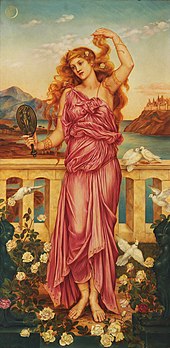
In 1864, Paris saw the premiere of theoperettaLa belle HélènebyJacques Offenbach.
Helen of Troy is a minor character in theoperaMefistofelebyArrigo Boito,which received its premiere in Milan in 1868.
In 1881,Oscar Wildepublished a poem entitled "The New Helen",[88]in which he declared his friendLillie Langtryto be thereincarnationof Helen of Troy.[88]Wilde portrays this new Helen as the antithesis of the Virgin Mary,[88]but endows her with the characteristics ofJesus Christhimself.[88]The Irish poetWilliam Butler Yeatscompared Helen to his muse,Maude Gonne,in his 1916 poem "No Second Troy".[90]The anthologyThe Dark TowerbyC. S. Lewisincludes a fragment entitled "After Ten Years". In Egypt after the Trojan War, Menelaus is allowed to choose between the real, disappointing Helen and an ideal Helen conjured by Egyptian magicians.
The EnglishPre-RaphaelitepainterEvelyn De Morganportrayed a sexually assertive Helen in her 1898 paintingHelen of Troy.[88]Salvador Dalíwas obsessed with Helen of Troy from childhood[88]and saw his wifeGala Dalíand the surrealist characterGradivaas the embodiments of Helen.[88]He dedicates his autobiographyDiary of a Geniusto "my genius Gala Gradiva, Helen of Troy, Saint Helen, Gala Galatea Placida."[88]
Minor planet101 Helenadiscovered byJames Craig Watsonin 1868, is named after Helen of Troy.
20th century[edit]
John Erskine's 1925 bestselling novelThe Private Life of Helen of Troyportrayed Helen as a "sensible,bourgeoisheroine ",[88]but the 1927silent filmof the same name,directed byAlexander Korda,transformed Helen into "a shopaholic fashion maven".[88]
In 1928,Richard Strausswrote the German operaDie ägyptische Helena(The Egyptian Helena), which is the story of Helen and Menelaus's troubles when they are marooned on a mythical island.[91]
The 1938 short story, "Helen O'Loy",written byLester del Rey,details the creation of a synthetic woman by two mechanics. The title is wordplay that combines "Helen of Troy" with "alloy".
The 1951 Swedish filmSköna Helenais an adapted version ofOffenbach's operetta,starringMax HansenandEva Dahlbeck.In 1956, a Franco-British epic titledHelen of Troywas released, directed by Oscar-winning directorRobert Wiseand starring Italian actressRossana Podestàin the title role. It was filmed in Italy, and featured well-known British character actors such asHarry Andrews,Cedric Hardwicke,andTorin Thatcherin supporting roles.
The 1971 filmThe Trojan Womenwas an adaptation of the play by Euripides in whichIrene Papasportrayed (a non-blonde) Helen of Troy.
In the 1998 TV seriesHercules,Helen appears as a supporting character at Prometheus Academy as a student. Helen is caring and enthusiastic. She was the most popular girl in the academy and Adonis' girlfriend. Helen tries her best to keep Adonis from behaving stupidly, but mostly fails. She likes Hercules, but as a friend. She is a princess as in the myth but is not a half-sister of Hercules in the series. She was voiced byJodi Benson.
21st century[edit]
A 2003 television version of Helen's life up to the fall of Troy,Helen of Troy,in which she was played bySienna Guillory.In this version, Helen is depicted as unhappy in her marriage and willingly runs away with Paris, with whom she has fallen in love, but still returns to Menelaus after Paris dies and Troy falls.
Helen was portrayed byDiane Krugerin the 2004 filmTroy.In this adaptation, as in the 2003 television version, she is unhappily married to Menelaus and willingly leaves with Paris, whom she loves. However, in this version she does not return to Sparta with Menelaus (who is killed by Hector), but escapes Troy with Paris and other survivors when the city falls.
Jacob M. Appel's 2008 play,Helen of Sparta,retellsHomer'sIliadfrom Helen's point of view.[92]
Inspired by the line, "Was this the face that launched a thousand ships...?" fromMarlowe'sFaustus,Isaac Asimovjocularly coined the unit "millihelen"to mean the amount of beauty that can launch one ship.[93]Canadian novelist and poetMargaret Atwoodre-envisioned the myth of Helen in modern, feminist guise in her poem "Helen of Troy Does Countertop Dancing".[94]
In theLegends of Tomorrowepisode "Helen Hunt", Helen is portrayed by Israeli-American model and actressBar Paly.In the episode, Helen is an anachronism appearing in 1930s Hollywood. She lands a job as an actress and unintentionally starts a war between two film studios. The Legends travel to the 1930s and try to get Helen back to the Bronze Age. She regretfully goes along, telling the team she wishes to stay away. After analyzing historical records of her impact on history,Zari Tomazfinds the best time to take her away from the fighting of her time and takes her toThemyscira.[95]Helen reappears in the season three finale, "The Good, the Bad and the Cuddly", as an Amazon warrior who assists the Legends in defeating the demon Mallus's army.[96]
In the 2018 TV miniseriesTroy: Fall of a City,Helen was portrayed byBella Dayne.[97]
Pop singer-songwriterAl Stewartreleased a song called "Helen andCassandra"on the reissue of his 1988 albumLast Days of the Century.In it he addresses many aspects of the Helen myth and contrasts her with the seer Cassandra.
Indie pop singerLordereleased a song called "Helen of Troy" for the deluxe version of her 2021 albumSolar Power.
See also[edit]
Notes[edit]
- ^pronounced[helénɛː]
- ^Interchangeable usage of the termsrapeandelopeoften lends ambiguity to the legend.[example needed]
- ^However, the meeting with Helen inMarlowe'splay and the ensuingtemptationare not unambiguously positive, since they are closely followed byFaust'sdeath and descent to Hell.
- ^The name of Helen as worshipped atSpartaandTherapnebegan with adigamma.On the other hand, atCorinth,there is evidence of Helen without a digamma. Skutsch (Helen,189 f. andpassim) suggests that we have to make do "with two different names, two different mythological Helens".
- ^CompareProto-Indo-European*sa(e)wol,whence Greekhelios,Latinsol,Sanskritsuryah,ultimately from*sawel"to shine". The relation with Selene is quite possible.
- ^If the name has anIndo-Europeanetymology, it is possibly a suffixed form of aProto-Indo-European root*wel-"to turn, roll"[10](or from that root's sense "to cover, enclose" – compare the theonymsVaruna,Veles),[citation needed]or of*sel-"to flow, run".[citation needed]The latter possibility would allow comparison to theVedic SanskritSaraṇyū,a character who is abducted inRigveda10.17.2. This parallel is suggestive of aProto-Indo-European abduction myth.Saraṇyūmeans "swift" and is derived from the adjectivesaraṇa( "running, swift" ), the feminine of which issaraṇā;this is in every sound cognate withἙλένα,the form of her name that has no initialdigamma.[d]The possible connection of Helen's name to ἑλένη ( "torch" ), as noted above, may also support the relationship of her name to Vedicsvaranā( "the shining one" ).[e][11]
- ^In the 5th century comedy "Nemesis" byCratinus,Leda was told to sit on an egg so that it would hatch, and this is no doubt the egg that was produced by Nemesis (Cratinus fr. 115PCG;Gantz,Early Greek Myth,ibid).
- ^Ancient writers do not agree on whether the embassy was dispatched before the gathering of the Greek army in Aulis or after it reached Tenedos or Troia. In Herodotus' account the Trojans swore to the Greek envoys that Helen was in Egypt, not in Troy; but the Greeks did not believe them, and laid siege to the city, until they took it.
Cypria.fr. 1.
Herodotus.Histories.II, 118: 2–4.
Homer.Iliad.III, 205.
Pseudo-Appolodorus.Epitome.28–29. - ^According to the ancient writers, it was the sight of Helen's face or breasts that made Menelaus drop his sword. See,inter alia,Aristophanes,Lysistrata,155;Little Iliad,fr. 13 EGF.
* Maguire,Helen of Troy,52 - ^A shared cult of Helen and her brothers in Attica is alluded to in Euripides,Helen,1666–1669.See also Edmunds,Helen's Divine Origins,26–29. Concerning Helen Dendritis, Gumpert (Grafting Helen,96), and Skutsch (Helen,109) support that she was a vegetation goddess. Meagher (The Meaning of Helen,43 f.) argues that her cult in Rhodes reflects an ancient fertility ritual associated with Helen not only on Rhodes but also at Dendra, near Sparta. Edmunds (Helen's Divine Origins,18) notes that it is unclear what an ancient tree cult might be.
References[edit]
- ^abCypria,fr. 9PEG.
- ^Galt, John, ed. (1837).The Complete Works of Lord Byron.Paris: Baudry's European Library. p. 553.
- ^Lang, Andrew (1892).Helen of Troy.Library of Alexandria. p. Title page.ISBN978-1465600868.
- ^Benjamin, S.G.W. (1880).Troy: Its Legend, History and Literature.C. Scribner's sons. p. v.
- ^abSmith, William, ed. (1870).A Dictionary of Greek and Roman Biography and Mythology.Vol. 2. Boston: Little, Brown, and Company. p. 370. ark:/13960/t9f47mp93.
- ^Way, Authur (1930).Euripides.Vol. 1. Londo & New York: William Heinemann, G. P. Putnam's Sons. p. 463. ark:/13960/t2v41093b.
- ^West, M. L. (2007).Indo-European Poetry and Myth.OUP Oxford. p. 231.ISBN978-0-19-928075-9.
- ^ἑλένη.Liddell, Henry George;Scott, Robert;A Greek–English Lexiconat thePerseus Project.
- ^Clader,Helen,63 f.; Skutsch,Helen,191.
- ^The American Heritage Dictionary,"Indo-European roots: wel₂".
- ^Scutsch,Helen,190 ff.
- ^abSkutsch, Otto."Helen, her Name and Nature."In:Journal of Hellenic Studies107 (1987), pp. 188–193.
- ^Meagher, Robert E. (2002).The Meaning of Helen: In Search of an Ancient Icon.Bolchazy-Carducci Publishers. pp. 46ff.ISBN978-0-86516-510-6.
- ^Mallory, J. P.; Adams, D. Q.,Encyclopedia of Indo-European Culture,Fitzroy Dearborn Publishers,1997,ISBN1-884964-98-2,p.164
- ^Euripides, Robert E. Meagher,Helen,Univ of Massachusetts Press, 1986
- ^O'Brien, Steven. "Dioscuric Elements in Celtic and Germanic Mythology".Journal of Indo-European Studies10:1 & 2 (Spring–Summer, 1982), 117–136
- ^Jackson, Peter (2002). "Light from Distant Asterisks. Towards a Description of the Indo-European Religious Heritage".Numen.49(1): 61–102.doi:10.1163/15685270252772777.ISSN0029-5973.JSTOR3270472.
- ^West, M. L. (2007).Indo-European Poetry and Myth.OUP Oxford. p. 137.ISBN978-0-19-928075-9.
- ^Meagher,The Meaning of Helen,11–18; Thompson,The Trojan War,20
- ^Hughes,Helen of Troy,29
- ^Banou, Emilia (2009)."The Mycenaean Presence in the Southeastern Eurotas Valley: Vouno Panagias and Ayios Georgios".British School at Athens Studies.16.British School at Athens: 77–84.JSTOR40960624.RetrievedJanuary 16,2023.
- ^Graves, Robert (2017).The Greek Myths - The Complete and Definitive Edition.Penguin Books Limited. p. 637.ISBN9780241983386.
- ^Homer,Iliad,III,199,418,426;Odyssey,IV,184,219;XXIII,218.
* Gantz,Early Greek Myth,318–9 - ^Euripides,Helen16–21Archived2016-04-10 at theWayback Machine,257–59Archived2016-04-10 at theWayback Machine
- ^First Vatican Mythographer, VM I 204.
* Gantz,Early Greek Myth,320–321; Hughes,Helen of Troy,350; Moser,A Cosmos of Desire,443–444 - ^Whitbread, Leslie George (1972).Fulgentius the Mythographer.Ohio State University Press. p. 78.ISBN9780814201626.
- ^Pseudo-Apollodorus,Bibliotheca,III, 10.7Archived2016-04-10 at theWayback Machine
- ^Athenaeus8.334b-d, quoting theCypria;Cypria,fr. 10PEG.
- ^Pseudo-Apollodorus,Bibliotheca,III, 10.7Archived2016-04-10 at theWayback Machine
* Hard & Rose,The Roudledge Handbook,438–439 - ^Asclepiades 12F11, Pseudo-EratosthenesCatast.25.
- ^Gantz,Early Greek Myth,ibid
- ^Pausanias, 3.16.1
* Hughes,Helen of Troy,26–27 - ^Pausanias,3.26.2
- ^Hornblower,p. 142;Lycophron,87
- ^The most complete accounts of this narrative are given by Apollodorus, Diodorus 4.63.1–3, and Plutarch,Theseus31–34. For a collection of ancient sources narrating Helen's abduction by Theseus, see Hughes,Helen,357; Mills,Theseus,7–8
- ^Hellanicus, 4F134; Diodorus Siculus, 4.63.1–3
- ^Stesichorus, fr. 191 PMG.
- ^Gantz, pp. 289, 291.
- ^Ovid,Heroides,16.149–152;Propertius,3.14
* Cairns,Sextus Propertius,421–422; Hughes,Helen of Troy,60; Pomeroy,Spartan Women,28: "In the Roman period, because Sparta was a destination for tourists, the characteristics that made Sparta distinctive were emphasized. The athleticism of women was exaggerated." - ^"Panorama with the Abduction of Helen Amidst the Wonders of the Ancient World".The Walters Art Museum.
- ^In the HesiodicCatalogue of Womenfr. 198.7–8, and 199.0–1, they are the recipients of the bridal presents. For further details, seeA Catalog within a Catalog,133–135
- ^Hesiod,Catalogs of Women and Eoiae,fr. 204; Hyginus,Fables,78;Pausanias, 3.20.9;Apollodorus, 3.10.9
* Cingano,A Catalog within a Catalog,128; Hughes,Helen of Troy,76 - ^Cypria,fr. 1; Hesiod,Catalogs of Women and Eoiae,fr. 204.96–101
* Edmunds,Helen's Divine Origins,7–8 - ^Cypria,fr. 1; Herodotus,113–119
- ^Sappho, fr. 16. See an analysis of the poem by Gumpert,Grafting Helen,92
- ^Dio Chrysostom,Discourses,1.37–53
* Hughes,Helen of Troy,128–129 - ^Cypria,fr. 1; Homer,Iliad,III,443–445
* Cyrino, "Helen of Troy", 133–134 - ^Kimmelman, Michael (March 1, 2007)."Lights! Darks! Action! Cut! Maestro of Mise-en-Scène".The New York Times.RetrievedJuly 11,2009.
*Schjeldahl, Peter (February 12, 2007)."Venetial Brass".The New Yorker.RetrievedJuly 11,2009. - ^Allan,Introduction,18–28
- ^HELENwsu.edu
- ^abSmoot, Guy (2012)."Did the Helen of the Homeric Odyssey ever go to Troy?".Washington, D.C.: Center for Hellenic Studies.Archived fromthe originalon 2018-11-05.Retrieved2018-11-04– via The Center for Hellenic Studies.
- ^Herodotus,113–120;Kim,Homer, poet and historian,30–35; Allan,Introduction,22–24; Lindsay,Helen in the Fifth Century,135–138
- ^Euripides.Iphigenia in Aulis.1166–1170.
- ^Hughes.Helen of Troy.pp. 195–196.
- ^About Euripides' lost drama, seeHughes.Helen of Troy.p. 191.
- ^abHughes.Helen of Troy.p. 219.
- ^abRedfold.The Tragedy of Hector.p. 122.
- ^Homer.Iliad.XXIV, 773–775.
- ^Suzuki.Metamorphoses of Helen.p. 36.
- ^Homer.Iliad.VI, 349–351, 354–356.
- ^Homer,Odyssey,IV,277–289;Virgil,Aeneid,515–519.
* Hughes,Helen of Troy,220; Suzuki,Metamorphoses of Helen,99–100. - ^Virgil,Aeneid494–512
* Suzuki,Metamorphoses of Helen,101–102. - ^Stesichorus, fr. 201 PMG.
- ^Euripides,Orestes1286
- ^Euripides and the Gods, Mary R. Lefkowitz
- ^Blondell,Helen of Troy46
- ^"Pausanias,Description of Greece".Perseus.tufts.edu.Retrieved2014-03-13.
- ^Pierre Grimal,The Dictionary of Classical Mythology,s.v."Helene p. 241"
- ^Pliny,National History,35.64–66.Cicero (De Inventione,2.1–3) sets the story inCroton.
- ^Mansfield,Too Beautiful to Picture,29
- ^Hughes,Helen of Troy1–2
- ^Dares of Phrygia.History of the Fall of Troy 12.A short prose work which purports to be a first hand account of the Trojan War by Dares, a Trojan priest of Hephaestus in theIliad.
- ^Pomeroy,Spartan Women,169
- ^Anderson,The Fall of Troy,257; Matheson,Polygnotos and Vase Painting,225
- ^Caprino,Etruscan Italy,66–71
- ^David,Narrative in Context,136; Hughes,Helen of Troy,181–182
- ^Maguire,Helen of Troy,39–43, 47
- ^Theocritus,The Epithalamium of Helen,43–48
* Edmunds,Helen's Divine Origins,12 - ^Herodotus,Histories,VI, 61.3
* Hughes,Helen of Troy,30–31; Lynn Budin,The Ancient Greeks,286 - ^"A Dictionary of Greek and Roman Antiquities (1890), MACELLUM, MATRA´LIA, MENELAEIA".perseus.tufts.edu.
- ^Isocrates,Helen,63;
Clader,Helen,70;
Jackson,The Transformations of Helen,52.
For a criticism of the theory that Helen was worshiped as a goddess in Therapne, see Edmunds,Helen's Divine Origins,20–24. - ^Euripides,Helen,translated by Robert E. Meagher, University of Massachusetts Press, Amherst 1986.
- ^Pausanias,Description of Greece,III,15.3,and19.9;
Allan,Introduction,14 ff.;
Calame,Choruses of Young Women,192–197;
Pomeroy,Spartan Women,114–118. - ^Cited by Gumpert,Grafting Helen,96, Edmunds,Helen's Divine Origins,15–18, and Skutsch,Helen,109. See critical remarks on this theory by Edmunds,Helen's Divine Origins,16.
- ^Calame,Choruses of Young Women,201;
Eaverly,Archaic Greek Equestrian Sculpture,9;
Pomeroy,Spartan Women,162 f. - ^abcdefgMaguire, Laurie (2009).Helen of Troy: From Homer to Hollywood.Chichester, England: John Wiley & Sons, Ltd. pp. 160–163.ISBN978-1-4051-2634-2.
- ^abCasson, Lionel (1962).Selected Satires of Lucian, Edited and Translated by Lionel Casson.New York City, New York: W. W. Norton and Company.ISBN0-393-00443-0.
- ^abcdefghijklmnopqrstuvwxyBlondell, Ruby (2013).Helen of Troy: Beauty, Myth, Devastation.Oxford, England: Oxford University Press. pp. 247–249.ISBN978-0-19-973160-2.
- ^Beolens, Bo; Watkins, Michael; Grayson, Michael (2011).The Eponym Dictionary of Reptiles.Baltimore: Johns Hopkins University Press. xiii + 296 pp.ISBN978-1-4214-0135-5.( "Helena", p. 120).
- ^"36. No Second Troy. Yeats, W. B. 1916. Responsibilities and Other Poems".Bartleby.Retrieved2014-03-13.
- ^Baxter, Richard (2002). "Die ägyptische Helena. Richard Strauss (recording review)".The Opera Quarterly.18(4): 643–647.doi:10.1093/oq/18.4.643.
- ^Horwitz, Jane.The Washington Post,December 16, 2008. P. C08.
- ^The Humanism of Isaac Asimov[usurped]
- ^"Helen of Troy Does Countertop Dancing by Margaret Atwood".Poemhunter. 20 January 2003.Retrieved2014-03-13.
- ^"Legends of Tomorrow Spoilers:" Helen Hunt "".DCLegendsTV. October 26, 2017.RetrievedNovember 14,2017.
- ^Burlingame, Russ."'Legends of Tomorrow' Season Finale Will Feature Helen of Troy As An Amazon ".comicbook.Retrieved12 April2018.
- ^"'Troy: Fall Of A City': Bella Dayne, Louis Hunter & More Join BBC/Netflix Epic ".Deadline.March 30, 2017.RetrievedApril 1,2017.
Additional references[edit]
Primary sources[edit]
- Aristophanes,Lysistrata.For an English translation see thePerseus Project.
- Cicero,De inventioneII.1.1–2
- Cypria,fragments 1, 9, and 10. For an English translation see theMedieval and Classical Literature Library.
- Dio Chrysostom,Discourses.For an English translation, seeLacus Curtius.
- Euripides,Helen.For an English translation, see thePerseus Project.
- Euripides,Iphigenia in Aulis.For an English translation, see thePerseus project.
- Euripides,Orestes.For an English translation, see thePerseus Project.
- Herodotus,Histories,Book II. For an English translation, see thePerseus Project.
- Hesiod,Catalogs of Women and Eoiae.For an English translation see theMedieval and Classical Literature Library.
- Homer,Iliad,BookIII;Odyssey,BooksIV,andXXIII.
- Hyginus,Fables.Translated in English byMary Grant.
- Isocrates,Helen.For an English translation, see thePerseus Project.
- Servius,In AeneidaI.526, XI.262
- Lactantius Placidus,Commentarii in Statii ThebaidaI.21.
- Little Iliad,fragment 13. For an English translation, see theMedieval and Classical Literature Library.
- Ovid,Heroides,XVI.Paris Helenae.For an English translation, see thePerseus Project.
- Pausanias,Description of Greece,Book III. For an English translation, see thePerseus Project.
- Pseudo-Apollodorus,Bibliotheca,BookIII;Epitome.
- Sappho,fragment 16.
- Sextus Propertius,Elegies,3.14.Translated in English byA.S. Kline.
- Theocritus,Idylls,XVIII (The Epithalamium of Helen). Translated in English byJ. M. Edmonds.
- Virgil,Aeneid.BookVI.For an English translation see thePerseus Project.
Secondary sources[edit]
- Allan, William (2008). "Introduction".Euripides: Helen.Cambridge University Press.ISBN978-0-521-83690-6.
- Anderson, Michael John (1997). "Further Directions".The Fall of Troy in early Greek Poetry and Art.Oxford University Press.ISBN0-19-815064-4.
- Blondell, Ruby (2013).Helen of Troy: Beauty, Myth, Devastation.Oxford University Press.ISBN978-0-19-973160-2.
- Blondell, Ruby (2023).Helen of Troy in Hollywood.Princeton: Princeton University Press.ISBN9780691229621.
- Cairns, Francis (2006). "A Lighter Shade of Praise".Sextus Propertius.Cambridge University Press.ISBN0-521-86457-7.
- Calame, Claude (2001). "Chorus and Ritual".Choruses of Young Women in Ancient Greece (translated by Derek Collins and Janice Orion).Rowman & Littlefield.ISBN0-7425-1525-7.
- Caprino, Alexandra (1996)."Greek Mythology in Etruria".In Franklin Hall, John (ed.).Etruscan Italy.Indiana University Press.ISBN0-8425-2334-0.
- Chantraine, Pierre (2000). "Ἐλένη".Dictionnaire Étymologique de la Langue Gercque(in French). Klincksieck.ISBN2-252-03277-4.
- Cingano, Ettore (2005). "A Catalog within a Catalog: Helen's Suitors in the Hesiodic Catalog of Women". In Hunter, Richard L. (ed.).The Hesiodic Catalog of Women.Cambridge University Press.ISBN0-521-83684-0.
- Clader, Linda Lee (1976).Helen.Brill Archive.ISBN90-04-04721-2.
- Cyrino, Monica S. (2006)."Helen of Troy".In Winkler, Martin M. (ed.).Troy: from Homer's Iliad to Hollywood.Cambridge University Press.ISBN1-4051-3182-9.
- David, Benjamin (2005). "Narrative in Context". In Jenkens, Lawrence A. (ed.).Renaissance Siena.Truman State University.ISBN1-931112-43-6.
- Eaverly, Mary Ann (1995). "Geographical and Chronological Distribution".Archaic Greek Equestrian Sculpture.University of Michigan Press.ISBN0-472-10351-2.
- Edmunds, Lowell (May 2007)."Helen's Divine Origins".Electronic Antiquity: Communicating the Classics.X(2): 1–44.Retrieved2009-07-07.
- Frisk, Hjalmar (1960). "Ἐλένη".Griechisches Etymologisches Wörterbuch(in German). Vol. I. French & European Pubns.
- Gantz, Timothy (2004).Early Greek Myth.Baltimore, MD and London: TheJohns Hopkins University Press.ISBN0-8018-5362-1.
- Gumpert, Matthew (2001). "Helen in Greece".Grafting Helen.University of Wisconsin Press.ISBN0-299-17124-8.
- Hard, Robin; Rose, Herbert Jennings (2004). "the Trojan War".The Routledge Handbook of Greek Mythology.Routledge.ISBN0-415-18636-6.
- Hornblower, Simon (2015).Lycophron: Alexandra: Greek Text, Translation, Commentary, & Introduction.Oxford University Press.ISBN978-0199576708.
- Hughes, Bettany (2005).Helen of Troy: Goddess, Princess, Whore.New York: Alfred A. Knopf.ISBN0-224-07177-7.
- Executive ed.: Joseph P. Pickert... (2000)."Indo-European roots: wel₂".The American Heritage Dictionary of the English Language.Houghton Mifflin Harcourt.ISBN0-395-82517-2.
- Jackson, Peter (2006). "Shapeshifting Rape and Xoros".The Transformations of Helen.J.H.Röll Verlag.
- Kim, Lawrence (2010). "Homer, poet and historian".Homer Between History and Fiction in Imperial Greek Literature.Cambridge University Press.ISBN978-0-521-19449-5.
- Lindsay, Jack (1974). "Helen in the Fifth Century".Helen of Troy: Woman and Goddess.Rowman and Littlefield.ISBN0-87471-581-4.
- Lynn Badin, Stephanie (2006). "Religion and Ideology".The Ancient Greeks.ABC-CLIO.ISBN1-57607-814-0.
- Maguire, Laurie (2009). "Beauty".Helen of Troy.John Wiley and Sons.ISBN978-1-4051-2635-9.
- Mansfield, Elizabeth (2007). "Helen's Uncanny Beauty".Too Beautiful to Picture.University of MinnesotaPress.ISBN978-0-8166-4749-1.
- Matheson, Susan B. (1996). "Heroes".Polygnotos and Vase Painting in Classical Athens.University of Wisconsin Press.ISBN0-299-13870-4.
- Meagher, Robert E. (2002).The Meaning of Helen.Bolchazy–Carducci Publishers.ISBN0-86516-510-6.
- Mills, Sophie (1997). "Theseus and Helen".Theseus, Tragedy, and the Athenian Empire.Oxford University Press.ISBN0-19-815063-6.
- Moser, Thomas C. (2004).A Cosmos of Desire.University of Michigan Press.ISBN0-472-11379-8.
- Nilsson, Martin Persson (1932). "Mycenaean Centers and Mythological Centers".The Mycenaean Origin of Greek Mythology.Forgotten Books.ISBN1-60506-393-2.
- Pomeroy, Sarah B. (2002). "Education".Spartan Women.Oxford University Press.ISBN0-19-513067-7.
- Redfield, James (1994). "The Hero".The Tragedy of Hector.Duke University Press.ISBN0-8223-1422-3.
- Rozokoki, Alexandra. "The Significance of the Ancestry and Eastern Origins of Helen of Sparta".Quaderni Urbinati Di Cultura Classica,New Series, 98, no. 2 (2011): 35–69.THE SIGNIFICANCE OF THE ANCESTRY AND EASTERN ORIGINS OF HELEN OF SPARTA.
- Skutsch, Otto (1987). "Helen, her Name and Nature".The Journal of Hellenic Studies.107:188–193.doi:10.2307/630087.JSTOR630087.S2CID161933465.
- Suzuki, Mihoko (1992). "The Iliad".Metamorphoses of Helen.Cornell University Press.ISBN0-8014-8080-9.
- Thompson, Diane P. (2004). "The Fall of Troy – The Beginning of Greek History".The Trojan War.McFarland.ISBN0-7864-1737-4.
- Whitby, Michael (2002). "Introduction".Sparta.Taylor & Francis.ISBN0-415-93957-7.
External links[edit]
- Helen of Troy
- Princesses in Greek mythology
- Queens in Greek mythology
- Children of Zeus
- Women of the Trojan war
- People of the Trojan War
- Characters in the Odyssey
- Kidnapped people
- Mythological rape victims
- Laconian mythology
- Deeds of Aphrodite
- Divine twins
- Ancient Spartan queens consort
- Children of Leda (mythology)


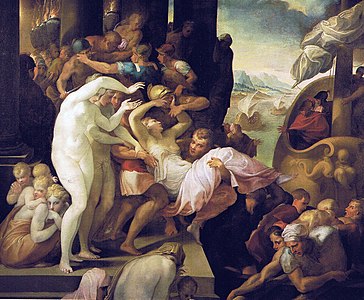
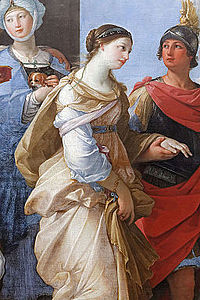
![The Rape of Helen by Tintoretto (1578–1579, Museo del Prado, Madrid); Helen languishes in the corner of a land-sea battle scene.[48]](https://upload.wikimedia.org/wikipedia/commons/thumb/5/59/Tintoretto_Rape_of_Helen.jpg/498px-Tintoretto_Rape_of_Helen.jpg)

